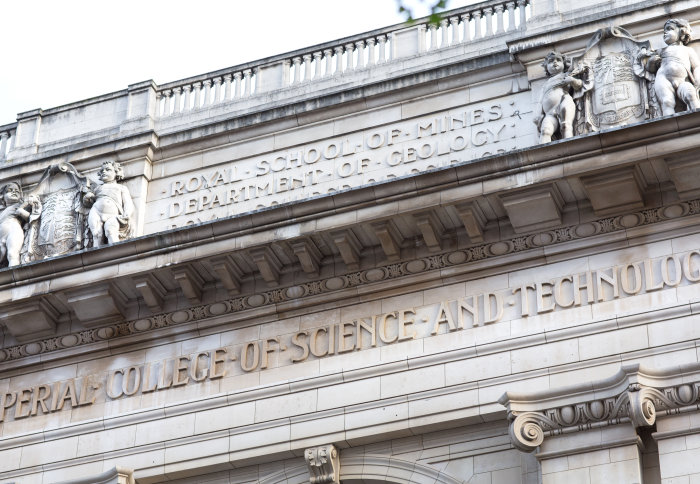ESE February Newsletter

ESE News
An overview of the recent publications, events and exciting work that's been happening in the Department of Earth Science and Engineering.
Contents
Publications
Conferences, Talks, Lectures, Seminars
Media and Impact
Outreach
Grants
Publications
Abdul Hamid, S. A., & Muggeridge, A. H. (2020). Fingering regimes in unstable miscible displacements. Physics of Fluids, 32, 016601 (2020); DOI: 10.1063/1.5128338
Cooke, D.R., Agnew, P., Hollings, P., Baker, M., Chang, Z., Wilkinson, J. J., Ahmed, A., White, N.C., Zhang, L., Thompson, J., Gemmell, J.B. and Chen, H. (2020). Recent advances in the application of mineral chemistry to exploration for porphyry copper–gold–molybdenum deposits: detecting the geochemical fingerprints and footprints of hypogene mineralization and alteration. Geochemistry: Environment, Exploration, Analysis. DOI: 10.1144/geochem2019-039
Erickson, T. E., Kirkland, C. L., Timms, N. E., Cavosie, A. J., & Davison, T. M. (2020). Precise radiometric age establishes Yarrabubba, Western Australia, as Earth’s oldest recognised meteorite impact structure. Nature Communications, 11, Article number: 300. DOI: 10.1038/s41467-019-13985-7
Galindo, P. A. and Lonergan, L. Basin evolution and shale tectonics on an obliquely convergent margin: the Bahia Basin, offshore Colombian Caribbean. Tectonics. 39. DOI: 10.1029/2019TC005787
Hnatyshin, D., Creaser, R.A., Meffre, S., Stern, R.A., Wilkinson, J. J. and Turner, E.C. (2019). Understanding the microscale spatial distribution and mineralogical residency of Re in pyrite: Examples from carbonate-hosted Zn-Pb ores and implications for pyrite Re-Os geochronology. Chemical Geology. DOI: 10.1016/j.chemgeo.2019.119427
Kampitsis, A. E., Adam, A., Salinas, P., Pain, C. C., Muggeridge, A. H., Jackson, M. D. (2020). Dynamic mesh adaptivity optimisation for immiscible viscous fingering. Computational Geosciences. DOI: 10.1007/s10596-020-09938-5
Lei, Q., Jackson, M. D., Muggeridge, A. H., Salinas, P., Pain, C. C., Matar, O.K., Årland, K. (2020). Modelling the reservoir-to tubing pressure drop imposed by multiple autonomous inflow control devices installed in a single completion joint in a horizontal well. Journal of Petroleum Science and Engineering 189. DOI: 10.1016/j.petrol.2020.106991
Nathwani, C. L., Loader, M. A., Wilkinson, J. J., Buret, Y., Sievwright, R. H., Hollings, P. (2020) Multi-stage arc magma evolution recorded by apatite in volcanic rocks. Geology, 48 (4). DOI: https://doi.org/10.1130/G46998.1
Sitorus, F. and Brito-Parada, P. R. (2020). Equipment selection in mineral processing - A sensitivity analysis approach for a fuzzy multiple criteria decision making model. Minerals Engineering, 150. DOI: 10.1016/j.mineng.2020.106261
Wallwork, J. G., Barral, N., Ham, D. A, & Piggott, M. D. (2020). Anisotropic Goal-Oriented Mesh Adaptation in Firedrake. Proceedings of the 28th International Meshing Roundtable, 83-100. DOI: 10.5281/zenodo.3653101
Conferences, Talks, Lectures, Seminars
From 6-8th January, the Natural History Museum and the LODE Research Group hosted the Annual Winter Meeting of the UK's Mineral Deposits Studies Group which was specially organised this year with a low carbon footprint. They were honoured to be able to kick off proceedings with a sold-out "Porphyry Ore Deposits Masterclass" workshop given by one of the world's leading geoscience consultants, Dr Richard Sillitoe. The meeting held "in the round" in the Attenborough Studio.
Two days of excellent poster and oral presentations followed, including talks by Prof. Richard Herrington - "The minerals supply challenge of a net zero carbon pledge", Chetan Nathwani - "The magmatic evolution of the Yarabamba batholith, Southern Peru: protracted magmatism culminating in multi-centred giant porphyry Cu-Mo mineralisation" and Matt Loader - "Accessory mineral chemistry reveals the petrogenesis of an evolving porphyry magma system: Chuquicamata and the Fortuna Complex, Chile", plus co-authorship of three other presentations by Jamie Wilkinson.
ESE staff and students also co-authored 10 posters, with contributions from PhD students Emily Brugge, Tom Matthews and Ethan Tonks, plus the LODE-hosted MSci students Holly Andrews, Harry Brookes, Dan Lindsay and Adam Smith. The conference banquet was a major highlight which, through generous support from new sponsor BHP plus First Quantum Minerals, Olympus, TESCAN and Zeiss, was an amazing Indian Banquet held in the museum's Earth Hall.
The conference finished on a high with a clean sweep of the student prizes by ESE with Rio Tinto best student talk prize going (for a second year in succession!) to Chetan Nathwani and the Anglo American poster prize to Emily Brugge.
Media and Impact
Thomas Davison's work on impact cratering was featured in BBC News, New York Times and The Guardian. If you want to find out more about the Earth's oldest meteorite impact structure, you can listen to Thomas on the BBC 5 live science show, or the Naked Scientists podcast!

PhD student Victoria Fernandes recorded a short interview about her research on landscape evolution with Victoria Murphy.
Outreach
As part of the impact activity of the NERC "FAMOS" project, Jamie Wilkinson and Matt Jackson contributed to an outreach article and activity sheet produced by Futurum, a not-for-profit organisation that encourages young people to consider careers in STEMM subjects. The article entitled "Magma detectives: studying volcanic arcs to find valuable minerals in Earth's crust" can be viewed here!
Grants
The £2.5M NERC Highlight Topic project - Copper Basins Exploration Science "CuBES" - kicked off in February, with an initial planning meeting held at the Natural History Museum on the 11th. The project is addressing the origin of, and developing exploration tools for, Cu, Co and V resources in sedimentary basins. These elements are critical to battery technology and electricity transmission and are therefore key components of the carbon-free energy transition. Diverse basin architectures and processes were responsible for the genesis of these deposits yet we still do not understand why so few basins become highly endowed with metals.
The project aims to address the fundamental geodynamic and geological context for the development of exceptionally endowed Cu-Co(-V) basins and establish how they are best identified. 10 UK HEIs are involved in the project with two of the work packages being led by ESE staff:
- Matt Jackson: "Experimental and Numerical Flow Modelling";
- Jamie Wilkinson: "Exploration Tools".
Article text (excluding photos or graphics) © Imperial College London.
Photos and graphics subject to third party copyright used with permission or © Imperial College London.
Reporter
Miss Cristina Saceanu
Department of Earth Science & Engineering